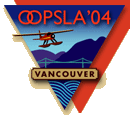
| Program |
 |
|
|
|
| Find in Program |
 |
|
|
|
| Page |
 |
|
|
|
| Basket |
 |
|
view, help
"MDA and Other Model-Oriented Technologies"
|
|
|

|
MDA and Other Model-Oriented Technologies
Meeting Room 10
Monday, 8:30, half day | 7 | · | 8 | · | 9 | · | 10 | · | 11 | · | 12 | · | 13 | · | 14 | · | 15 | · | 16 | · | 17 | · | 18 | · | 19 | · | 20 | · | 21 |
Krzysztof Czarnecki, University of Waterloo: Krzysztof Czarnecki is an Assistant Professor at the University of Waterloo, Canada. Before coming to Waterloo, he spent 8 years at DaimlerChrysler Research working on the practical applications of generative programming (GP). He is co-author of the book "Generative Programming" (Addison-Wesley, 2000), which is regarded as founding work of the area and is used as a graduate text at universities around the world. He was General Chair of the 2003 International Conference on Generative Programming and Component Engineering (GPCE). His current research focuses on realizing the synergies between GP and MDA.
David S. Frankel, David Frankel Consulting: David Frankel Consulting, 741 Santiago Court , Chico, CA 95973 USA, Phone +1 (530) 893-1100
Petter Graff, Inferdata Corporation: Petter Graff is Vice President of InferData Corporation. He has developed object-oriented systems for more than 20 years. At InferData, his focus is in object-oriented component development, software architectures and advanced implementation techniques for enterprise applications. He created one of the first model transformation tools (MCC) and is currently responsible for the development of InferData's next generation agent based model transformation tool. Petter is also coauthoring an upcoming book on Model Driven Development.
Tutorial number: 23
Today, application development still remains a
laborious process with relatively little reuse and
automation. Application programmers have to manually
map their high-level analysis models to target
platform architectures such as J2EE and .NET and
eventually to code. Rather than focusing on the
problem domain, they have to deal with the complex
details of the target platforms. The analysis and
design models—being just additional documentation
artifacts—are often not properly maintained in the
face of approaching deadlines. This makes the
applications hard to evolve later. Retargeting an
application to a new platform is almost as difficult
as writing it from scratch.
Model-Driven Architecture (MDA) is a set of standards
being defined by the Object Management Group (OMG)
that aims at promoting interoperability among
model-oriented tools that address the above-mentioned
problems. In MDA, models are not merely design
artifacts; they are part of the primary source of an
application. Many other artifacts such as code, tests,
and documentation are (completely or partially)
automatically derived from models.
In this tutorial, we will take a critical look at the
promises made by MDA and clearly distinguish what is
possible today from the visions of tomorrow. After
explaining basic MDA concepts such as metamodeling and
model transformations, we'll discuss tool requirements
and review some existing MDA tools. We'll also examine
other model-oriented approaches that are not based on
the MDA standards, such as Microsoft's modeling
technology. We'll round up the tutorial with a demo
of generating a complete J2EE and .NET application
from the same high level UML model.
Intermediate: This tutorial aims at software developers, architects,
and researchers interested in ways to automate
application development. Attendees should have basic
knowledge of UML.
|
